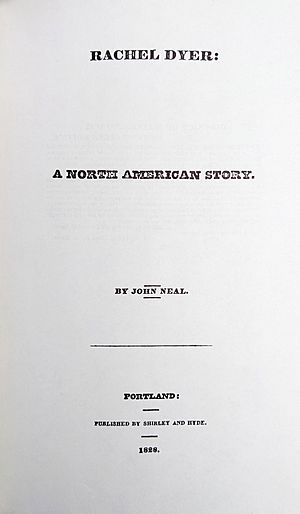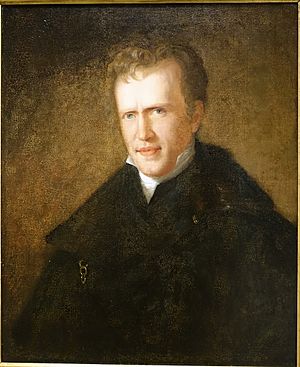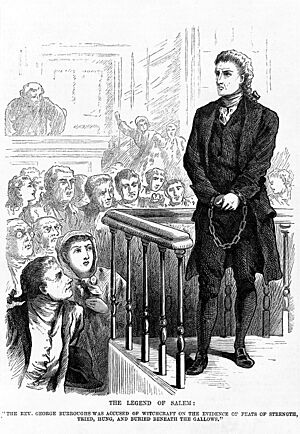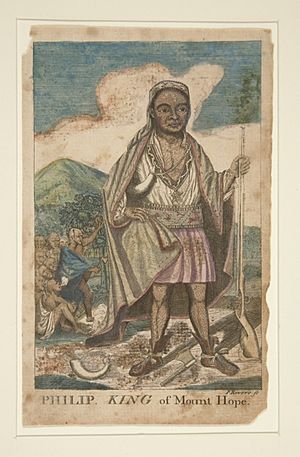Rachel Dyer facts for kids

Title page
|
|
| Author | John Neal |
|---|---|
| Country | United States |
| Language | English |
| Genre | Historical fiction Gothic fiction |
| Set in | Salem witch trials |
| Publisher | Shirley and Hyde |
|
Publication date
|
1828 |
| Pages | 276 |
| OCLC | 1049117822 |
Rachel Dyer: A North American Story is a Gothic historical novel written by American author John Neal. It was published in 1828 in Maine. This book is important because it was the first full-length novel about the famous Salem witch trials.
Even though it wasn't very popular when it first came out, Rachel Dyer later influenced many famous writers. These included Nathaniel Hawthorne, Henry Wadsworth Longfellow, John Greenleaf Whittier, and Walt Whitman. The novel is also known for its special introduction, called "Unpublished Preface." This essay talks about creating a unique American style of writing.
The story follows a dark and poetic path. It focuses on a real person, George Burroughs, and a made-up character, Rachel Dyer. Rachel is a victim of the witch panic. Much of the book takes place in a courtroom, showing the trials of many people accused of witchcraft.
The novel explores big ideas like fairness and how Indigenous people were treated badly by the Puritans. It also looks at the idea of American unity and how new American ideas could fix old problems.
John Neal first wrote Rachel Dyer as a short story in 1825. He expanded it after returning home from London. Neal tried out new ways of writing speech and dialogue. He hoped this style would become a key part of American literature. Many people think Rachel Dyer is Neal's best novel. It was not printed again until 1964.
Contents
Understanding the Story of Rachel Dyer
The novel begins by explaining the history leading up to the Salem witch trials. The narrator tells us that many people in the 1690s, even educated ones, believed in witchcraft. This belief was common in both the United Kingdom and British North America.
Puritans and Early Conflicts
When Puritans came to New England from England, they faced challenges. They quickly became violent towards Quaker colonists and Wampanoag Indigenous people. A Quaker woman named Mary Dyer was executed for her religious beliefs. Another Quaker, Elizabeth Hutchinson, then put a curse on those who persecuted them.
The book describes a series of bad events that seemed to fulfill this curse. These included King Philip's War, King William's War, diseases, an earthquake, fires, and storms. There were also conflicts within the church. All these events led to the witch trials. The narrator then introduces important figures like Governor William Phips and Reverend Matthew Paris.
The Start of the Witchcraft Accusations
Reverend Paris is sad because his wife recently died. He is easily scared and believes in superstitions. His life revolves around his ten-year-old daughter, Abigail Paris, and her twelve-year-old cousin, Bridget Pope. These girls start acting strangely, which Paris believes is caused by evil spirits.
Indigenous neighbors stop visiting Paris's home. He looks for a reason for the girls' behavior. He questions Tituba, an Indigenous servant who lives with him. Paris accuses Tituba of witchcraft. She is arrested and forced to confess. During this, she names Sarah Good as also being a witch.
George Burroughs and His Defense
Reverend George Burroughs appears at Sarah Good's trial. He is a Puritan minister with both European and Indigenous American family. He had been a minister in Falmouth (now Portland, Maine). Burroughs defends Sarah Good in court. He also criticizes the colonial leaders for breaking agreements and fighting unfair wars with the Iroquois.
Despite Burroughs's help, Sarah Good is found guilty. At her execution, she says she is innocent. She also predicts that other innocent people will be executed. Rachel Dyer, a new character in the story, shouts her support for Sarah Good from the crowd. Rachel is described as having a hunchback and red hair. She and her sister, Mary Elizabeth Dyer, are Quakers. They are also the granddaughters of Mary Dyer.
More Trials and Accusations
Later, a Salem resident named Martha Corey is accused of witchcraft. By the time of her trial, many more people have been arrested. Fear of being accused has spread throughout the town. Burroughs tries to defend Corey, but he is not successful. Martha Corey is executed after a speech from Increase Mather.
Burroughs visits Matthew Paris to understand how the witch panic started. He finds Paris's home full of fear. Burroughs then visits the Dyer sisters because they have spoken out against the witch panic. The three learn that arrest warrants have been issued for them in Salem. They try to escape but are captured on their way to Rhode Island.
While in prison, Burroughs tries to convince the Dyer sisters to falsely confess. He hopes this will delay their executions until the panic ends. But they refuse.
The Final Trials and Their Impact
Judith Hubbard, a Salem resident, is jealous of Burroughs's feelings for Mary Elizabeth Dyer. She testifies at his trial. She claims that Burroughs's two dead wives appeared to her as spirits. They told her that he had caused their deaths.
A boy named Robert Eveleth testifies that Hubbard, Abigail Paris (who is now dead), and Bridget Pope (who is dying) plotted against Burroughs. But Eveleth's testimony is not believed. Matthew Paris is also losing his mind and cannot help. Burroughs is found guilty based on Hubbard's testimony. Rachel Dyer comforts him. She is found guilty later that same day.
Burroughs is executed. Rachel Dyer dies in her prison cell, holding a bible. Their deaths as innocent victims help stop the witch panic. No one else, including Mary Elizabeth Dyer, is executed after them. The book ends with a section called "Historical Facts." Here, Neal explains how his story connects to real accounts of the witch trials.
Key Ideas in Rachel Dyer
"They were ministers of the gospel, who ... pursued their brethren to death, scourged, fined, imprisoned, banished".
Many experts see Rachel Dyer as a story about unfairness. This unfairness came from trying to force old European laws onto the new American way of life. Neal linked the stories of Quaker dissenters like Anne Hutchinson and Mary Dyer with the Salem witch trials. This shows his criticism of English Common law. This old law relied too much on past decisions, even if they were unfair. The witch trials are shown as a kind of supernatural payback for the unfair treatment of Dyer and Hutchinson.
Challenging Old Laws and Ideas
In the story, Burroughs questions the judges' decisions. They tell him that "such was the law, the law of the mother-country and therefore the law of the colonies." This means they were just following old English rules. The novel compares the old colonies of the 1690s with the new republican America of the 1820s. It highlights how much more value was placed on human life in the newer era. Some scholars believe this comparison also criticizes how early American society still relied on old traditions.
Neal also wanted to show the Puritans as important founders of the United States. He was a leader in the early American literary nationalist movement. This movement believed America needed its own unique writing style and legal system. Rachel Dyer was published the same year as Noah Webster's first dictionary. Both books were part of a search for a national American identity. Neal made George Burroughs, the main opponent of old laws, a character with both English and Indigenous American roots. This was one way Neal created his unique American literary style.
Gothic Elements and Influences
As a Gothic novel, Rachel Dyer uses dark descriptions and connects bad actions with dark places. It shows New England forests as a place of evil. It also suggests that superstition comes from being isolated in rural areas.
Nathaniel Hawthorne said that the novel's setting in Puritan Massachusetts influenced his book The Scarlet Letter. Some think that Sarah Good's curse in Rachel Dyer might have inspired a similar curse in Hawthorne's The House of the Seven Gables. After reading Rachel Dyer, John Greenleaf Whittier and Henry Wadsworth Longfellow were inspired to write about witchcraft in their own works.
Treatment of Indigenous Americans
Neal used the novel to criticize how European Americans treated Indigenous people. He defended Metacomet (also known as King Philip) from King Philip's War. Neal suggested that the witch panic was a supernatural punishment for the Puritans' bad treatment of their Indigenous neighbors. Some historians agree that worries about war might have caused the witch panic.
In the novel, Indigenous Americans represent life. However, the Puritans see them as connected to death and ignore their wisdom. Neal gave Burroughs a mixed-race identity. This character moves between white and Indigenous worlds. This challenges ideas of national unity and control. Neal used Burroughs's mixed background to criticize colonial America. He also hinted that the mistakes of the 1690s could happen again in his own time.
Inner Beauty and Challenging Norms
Neal stated that he wanted to show that "a towering intellect may inhabit a miserable body." He wanted to challenge the idea that good qualities only come with physical beauty. Rachel Dyer, despite her physical differences, shows strong morals and supports other women. Neal wrote at a time when many critics disliked books that didn't follow British writing rules. He wanted Rachel Dyer to go against these criticisms.
Behind the Scenes: How Rachel Dyer Was Written

John Neal was a frequent writer for Blackwood's Magazine while living in London. In 1825, he suggested writing a series of short stories about the US. He sent the first one in October of that year. The publisher accepted it but delayed printing it. Neal asked for it back in February 1826.
After returning to his hometown of Portland, Maine, in 1827, Neal started expanding the story. He used More Wonders of the Invisible World, a book republished in 1823, for research. The expanded story became Rachel Dyer. Neal later published the original short story as "New-England Witchcraft" in the New-York Mirror in 1839.
Neal likely chose George Burroughs as a main character because Burroughs had been a minister in Portland. Both Neal and Burroughs were also known for their physical strength. Some experts believe Neal might have added details from his own life to Burroughs's story. This made Burroughs seem more like a lawyer, similar to Neal himself. Neal was interested in history and law, so he would have used the Salem court records for his novel. The character Rachel Dyer was not a real person. Neal named her after his sister, Rachel Wilson Neal.
Rachel Dyer might have been part of Neal's effort to regain the respect of his hometown. Many people in Portland had been upset by his earlier novels. These books had characters based on local people, and Neal had criticized American authors in British magazines. Neal said he wrote Rachel Dyer hoping it would make up for his earlier "folly and extravagance." He also said he was done writing novels. Although he published two more novels later, he had written their first drafts before Rachel Dyer. He didn't write another full novel until 1859.
Neal's Unique Writing Style
Do thee mean to confess?
I — I! —
Ah George —
I cannot Rachel — I dare not — I am a preacher of the word of truth. But you may — what is there to hinder you?
Thee will not?
No.
Nor will I.
In Rachel Dyer, Neal experimented a lot with how people speak. This focus on dialogue was so strong that it sometimes overshadowed the plot and characters. This is especially true in the courtroom scenes, which make up two-thirds of the book. These scenes were a way for Neal to show the writing style he believed should define American literature.
Dialogue and American Voices
Neal tried many different ways of writing speech. This included long, fancy speeches and short, repeated whispers. He didn't use quotation marks in the novel. He felt they weren't needed if the dialogue was written well. Much of the dialogue also lacks tags like "he said" or "she said." Instead, it moves quickly between speakers.
Neal used crowded courtroom scenes to show a diverse nation. He wanted to show a country that moved away from old European ways. He also wanted to encourage conversations between different races and nationalities.
Like in his other novels, Neal used Rachel Dyer to write down how people actually spoke. He included the Yankee dialect for minor characters. This was Neal's attempt at literary realism. He wanted to show the US as a place with many different cultures. This early effort to record American dialects was even mentioned in the first Dictionary of American English over a century later.
"Unpublished Preface": A Call for American Writing
Rachel Dyer begins with a short preface and a longer essay called "Unpublished Preface to the North-American Stories." Neal wrote this essay in 1825 for Blackwood's Magazine. It was meant to introduce a series of short stories, but the editor didn't publish it.
This essay is like a strong statement for American literary nationalism. This was a movement in the 1820s that Neal was a big part of. The "Unpublished Preface" is much more famous among modern experts than the novel itself.
New Styles for a New Nation
The "Unpublished Preface" praises other American novelists for writing about American places and characters. However, it criticizes them for not creating new ways of writing and new styles of language. Neal argued that this could be done by experimenting with American slang, speech patterns, and regional accents.
He believed American novelists relied too much on British examples. He criticized Washington Irving for copying Joseph Addison and James Fenimore Cooper for copying Walter Scott. Neal famously said: "I shall never write what is now worshipped under the name of classical English ... the deadest language I ever met with."
Neal also promoted cultural pluralism in his essay. He criticized writers for only focusing on white characters as representing American identity. He blamed them for supporting ideas like manifest destiny and Indian removal. These ideas were becoming popular at the time. Unlike his earlier works, this essay showed Neal moving towards focusing on different American regions.
A New Declaration of Independence
Like the novel, the "Unpublished Preface" rejects old ways. It calls for "another Declaration of Independence, in the Great Republic of Letters." This idea was well-known for Neal. It appeared in all his previous novels. However, the essay also used the less controversial idea of literary nationalism to push for a more controversial idea: that American lawyers should stop using English Common law.
This challenge to old ways likely inspired Walt Whitman to write Leaves of Grass twenty-seven years later. Whitman probably read Rachel Dyer as a boy. Years later, he worked with Neal when Neal was an editor for Brother Jonathan magazine in 1843.
Publication History
Rachel Dyer was the first fictional book about the Salem witch trials to be published as a full novel. Before it, there was only Salem, an Eastern Tale (1820). That story was published anonymously in parts in a New York City magazine. It didn't get much attention.
Neal's novel was published in Portland, Maine, in 1828. It was not printed again during his lifetime. The first time it was republished was in 1964. This was done as a copy of the original book, with a new introduction. This was the first of Neal's major novels to be republished since Seventy-Six was reprinted in London in 1840.
|



